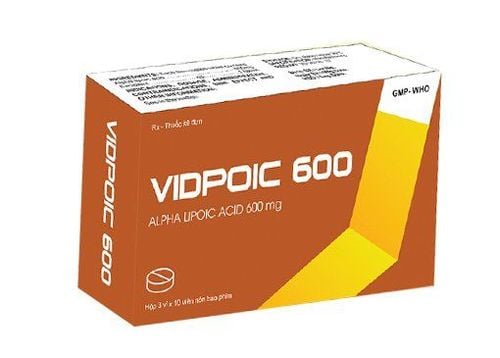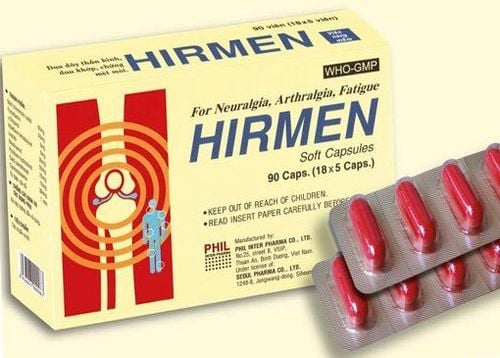This is an automatically translated article.
Posted by Doctor Nguyen Hong Phuc and Doctor Vo Ha Bang Suong - Vinmec Phu Quoc International General HospitalDemyelinating polyneuritis is a disease involving multiple cranial or peripheral nerves. This is one of the common neurological diseases, if not diagnosed correctly, the treatment will become very difficult.
1. What is chronic demyelinating polyneuropathy?
CIDP is a chronic and progressive autoimmune polyneuropathy. Manifested by progressive weakness and sensory impairment in the legs and arms. Caused by immune-mediated damage to the myelin sheath of peripheral nerves. In addition, the disease is also known as chronic demyelinating polyneuropathy.2. Causes of chronic demyelinating polyneuropathy
Currently, the cause of chronic demyelinating polyneuropathy is not clear, most of which are unknown (idiopathic CIDP). Accordingly, some CIDP diseases are accompanied by a number of diseases such as:HIV infection Lymphoma Osteosclerotic myeloma, POEMS, Castleman disease MGUS Active chronic hepatitis, hepatitis C Inflammatory diseases of the digestive tract Collagen disease Organ transplantation, transplantation bone marrow Nephrotic syndrome Diabetes mellitus Hyperthyroidism Hereditary peripheral neuropathy Central demyelinating disease
3. Epidemiology
The overall incidence is 1 to 2/105 people in the UK and Australia. The disease occurs in all ages, mostly in adults, with the highest incidence in the 50s and 60s.About 13-20% of peripheral neuropathy cases do not have a definitive diagnosis at baseline in neuromuscular center of the United States. Less than 10% had a history of infection prior to the onset of CIDP symptoms. Pregnancy is strongly associated with recurrent episodes of CIDP in women (last 3 months, postpartum period).
4. Clinical symptoms of chronic demyelinating polyneuropathy

Thất điều cảm giác là một trong những triệu chứng lâm sàng bệnh viêm đa dây thần kinh hủy myelin mạn tính
Two progression patterns Continuous progressive worsening (2/3 of cases) Progression with regress and recurrence (1/3) number of cases), complete or incomplete recovery between relapses. Age of onset has an effect on the disease progression phenotype - progressive progression (mean age 51 years) - recurrent course (mean age 29)
Proximal and distal limb weakness is symptomatic Predominant symptom at disease onset Paresthesia, pins and needles sensation of extremities Possible autonomic symptoms (vertigo due to postural hypotension, symptoms of bladder and bowel disturbances, arrhythmias) heart) Accordingly, symptoms persist for >8 weeks
4.2. Physical symptoms Walking disorder (more common in children) with manifestations such as drooping steps, sweeping feet (anterior tibial muscle paralysis). Footsteps slam into the ground (due to reduced depth perception). Weakness of the proximal extremities ± muscle atrophy, muscle tremor. Loss or decrease in tendon reflexes of the extremities. Loss of feeling. Sensory signs: Sensory deficits (shallow, deep sensation) like wearing gloves and socks. Pain of nerve origin (analgesia, dysesthesia). Cranial nerve palsy: Bilateral peripheral facial paralysis. Paralysis of the oculomotor nerve (III, IV, VI). Other cranial nerve palsies IX, X, XII (rare).
5. Subclinical diagnosis of chronic demyelinating polyneuropathy
5.1. Cerebrospinal fluid Protein levels are elevated in 80% of cases (50 mg/dL to 200 mg/dL). The number of cells is normal or slightly increased (< 10/mm3), lymphocytes predominate. 5.2. Electromyography (EMG) EMG is the key probe in CIDP, helping clinicians determine the nature of peripheral nerve damage and demonstrate the presence of peripheral demyelination.Electrical abnormalities of peripheral demyelination:
Peripheral motor potential prolongation Decreased conduction velocity < 70% of normal Multiple partial conduction blocks Diffuse in time of CMAPs Missing or potentially prolonged F waves Electromyographic abnormalities of secondary axonal injury 5.3. Imaging studies Indications MRI of the brain and spinal cord is indicated in the following cases:
It is performed to rule out other diseases, especially myelopathy. Rarely, demyelinating lesions of the central nervous system have been associated with CIDP. 5.4. Other laboratory tests Tests performed to screen for systemic diseases: Complete blood count, blood biochemistry, ANA, immunoelectrophoresis of blood and urine.

Các xét nghiệm được thực hiện để tầm soát các bệnh toàn thân bao gồm: Công thức máu, sinh hóa máu, ANA, miễn dịch điện di máu và nước tiểu
6. Definitive diagnosis of chronic demyelinating polyneuropathy
6.1. Definite diagnosis According to the main criteria of the American Society of NeurologyClinically there are movement and sensory disorders: Weakness in the distal extremities, proximal limbs or both, and slowly progressive sensory disturbances in more than one limb (> 1 limb.) or recurrence of more than one limb (recurrence >1 limb) Progression > 2 months Reflex: Decrease or loss The diagnosis of CIDP is further confirmed by the following laboratory evidence:
Cerebrospinal fluid: The amount of CSF protein is usually increased, the lymphocyte count is less than 10 10/mm (cell protein dissociation) There is an EMG abnormality of a demyelinating neuropathy. Electrodiagnostic is extremely important, but the sensitivity is only 60-70%, due to the presence of axonal damage secondary to demyelination. Criterion is a conduction delay 25% below the lower limit of normal, and a prolonged F latent time above 125%. There may also be dispersion over time. These abnormalities were present in more than 50% of the nerves examined. Nerve biopsies are rarely required except when done to rule out other conditions, such as vasculitis. There is 2 evidence to support the diagnosis: hyperattenuation and hypertrophy of the nerve roots in the neck and back (on MRI), and response to immunotherapy.
Thus, 2 mandatory diagnostic criteria are clinical and electrodiagnostic; Optional criteria were CSF, nerve biopsy, MRI imaging, and response to immunotherapy (Koski, 2009). In patients who have had a very advanced disease and are often unable to stimulate the nerves of the leg, the diagnosis can be made by clinical criteria, that is, the symmetric onset of motor symptoms, Symmetrical weakness in all extremities, and at least 1 limb with proximal weakness.
6.2. Differential Diagnosis The differential diagnosis of CIDP includes the following causes of polyneuropathy:
Guillain-Barré syndrome Multifocal motor neuropathy Paraneoplastic syndrome Toxic collagen vascular disease Multiple diseases nerves Vasculitis Chronic hepatitis (especially hepatitis C) HIV infection Diabetic neuropathy Alcoholic neuropathy
7. Treatment of chronic demyelinating polyneuritis

Corticoid là một trong những loại thuốc được dùng để điều trị CIDP
Immunosuppressive treatment and immunomodulatory treatment Symptomatic treatment 7.1. Immunosuppressive and immunomodulating therapy Corticosteroids Glucocorticoid: Oral prednisone has been shown to be effective in a randomized controlled trial. Initial dose is 60 to 80 mg/day orally once a day. (Children: 1.0 - 1.5 mg/kg) The drug begins to work after 2 months. When the drug is effective, it is changed to an oral regimen every other day and maintained at the same high dose until effective. The maximum therapeutic effect is achieved (more than 50% of patients achieve this response after 6 months of treatment). Reduce prednisone dose slowly thereafter (10 mg/month) Maintain prednisone regimen every other day (10-30 mg) for several years
Intravenous immunoglobulin (IVIG, intravenous immune globulin): IVIG After a proven controlled study benefit of high-dose IVIG in the treatment of CIDP. IGIV at a dose of 0.4 g/kg/day continuously for 5 days significantly improved the clinical status of 63% of the patients. The therapeutic effect is recorded in the first week, reaching a maximum after 6 weeks. Then continue: - 0.4 g/kg weekly for the next 3 weeks; - 0.2 g/kg per week for the last 3 weeks.
Plasma exchange Three controlled studies have demonstrated the benefit of plasma exchange in the treatment of CIDP. It has been shown that 10 plasma exchanges over 4 weeks result in a marked but short-term improvement in the condition of 80% of patients. Response appeared after only a few days but 70% of patients relapsed only 14 days after stopping treatment
Common protocol:
Week 1 to Week 2: 3 plasma exchanges per week (50 mL/kg) Week 3 to 6 weeks: 2 plasma exchanges per week. Then the number of exchanges is decided according to individual patient response. It is possible to maintain plasma exchange for many months to many years. Many patients require plasma exchange with prednisone.
Other immunosuppressive drugs Azathioprine (2 – 3 mg/kg/day) Mycophenolate mofetil (1000 mg x 2/day) Cyclosporine A 95 mg/kg divided twice daily) Cyclophosphamide (1 mg/m 2 per day) month for 3 to 6 months) -Interferon α (3 million IU subcutaneously 3 times per week, for 6 weeks) 7.2. Symptomatic treatment Counseling explains the chronic condition that is prone to recurring episodes. Mainly rehabilitation treatment. Anti depression. Treatment of complications during immunotherapy
8. Monitoring and prognosis of chronic demyelinating polyneuropathy

Bệnh nhân cần được theo dõi chặt chẽ đáp ứng với điều trị
8.2. Prognosis Chronic demyelinating polyneuropathy does not regress on its own but causes long-term neurological disability. 95% of patients with CIDP have an initial improvement, but the rate of recurrence is high. Poor recovery was noted in cases with associated axonal injury.
Approximately 80-85% of patients with CIDP will respond well to 1 of the 3 treatments mentioned above. There are 10-15% considered to be resistant to treatment and need to seek other treatment. A good predictor of prognosis is a subacute progression and is treated within the first 6 months, without muscle atrophy, bilaterally symmetrical presentation, and slow onset of the disease. It has been suggested that treatment with corticosteroids alone has a better outcome than treatment with IVIG alone.
Although it is a dangerous disease, people with the disease can have good control of demyelinating polyneuropathy if:
Periodic health check-ups to monitor the progression of symptoms as well as your health status ; Take medicine according to the instructions of the doctor, do not arbitrarily take medicine without being prescribed or arbitrarily quit during the treatment period; Actively exercise, exercise the body; Join a self-help group for support when you need it. In order to improve the quality of medical examination and treatment services, Vinmec International General Hospital now offers a variety of periodic health check-up service packages. When using these service packages, customers will be examined, tested and diagnosed, thereby providing timely treatment, minimizing possible dangerous complications.
Customers can directly go to Vinmec Health system nationwide to visit or contact the hotline here for support.
MORE:
Chronic demyelinating polyneuropathy (CIDP) Is polyneuritis dangerous? How to resolve? Polyradiculopathy and peripheral neuropathy in children














